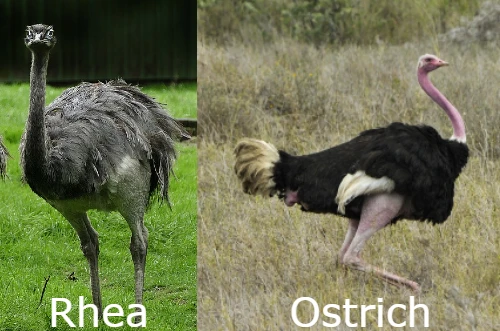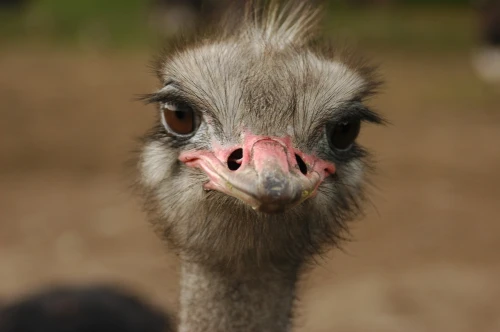A lot of people have a hard time telling the difference between an ostrich and a rhea. However, some very distinct differences make it easy to tell them apart. In this ‘Rhea vs Ostrich’ article, you will learn about these two birds and what makes them different from one another.

Ostrich vs Rhea Differences at a Glance
| Rhea | Ostrich | |
| Speed | 35 mph | 43 mph |
| Weight | 60 – 80 lbs. | 220 – 300 lbs. |
| Hight | 4′ 7″ to 5′ 7″ | 5′ 7″ to 6′ 7″ |
| Egg weight | 1.3 lbs. | 3 lbs. |
| Egg size (long x wide) | 5.1 in x 3.5 in | 6 in x 5.1 in |
| Eggshell | Greenish-yellow to dull-cream | Cream |
| Origin | South America | Africa |
| Lifespan | 20 years | 45 years |
Where They Come From?
While ostriches and rhea have similar appearances, they live on different continents.
Rheas are distantly related to the ostrich, but the Rheas come from South America. Ostrich, on the other hand, can be found in Africa.
The Number of Species
The IUCN recognizes three species of rheas:
- Greater rhea
- Lesser or Darwin’s rhea
- Puna rhea
There are two species of ostrich:
- Common ostrich (divided into four subspecies)
- North African ostrich
- South African ostrich
- Masai ostrich
- Arabian ostrich
- Somali ostrich
Flight: Rhea vs Ostrich
Both ostrich and rhea are flightless birds, but still have wings. Their bones’ structure makes flight impossible for both birds.
They both use their wings for balance when running long distances to escape predators. Their wings also act as blankets when they sleep.
Read more about the fascinating ostrich flying facts.
Speed: Rhea vs Ostrich

The ostrich is the fastest bird on land. Their speed can reach up to 43 mph (around 70 km/h).
Rhea, on the other hand, can run a little bit slower than the ostrich, at about 35 mph.
Still pretty fast for a flightless bird, faster than emus and cassowaries.
Size: Rhea vs Ostrich
There is a big difference in the size of the ostrich and rhea.
Male ostriches are the largest birds in the world, with body heights of 6′ 11″ to 9′ 2″ (210 – 280 cm) while female ostriches can range from 5′ 7″ to 6′ 7″ (170 – 200 cm) at full maturity (2-4 years old).
The rhea, on the other hand, is about 4′ 7″ to 5′ 7″ in tall (140 – 170 cm).
When it comes to weight differences between an ostrich and rhea, they’re drastic and worth mentioning.
An average male common ostrich weighs around 300 pounds while females weigh 220 pounds. These weights can vary depending on their location or diet, however!
In contrast, rheas are smaller than ostriches with males reaching a weight of 80 pounds and females up to 66 pounds.
Again, this can vary depending on the area.
The Look of the Birds

The physical appearance of these two birds also shows a difference between Rhea vs Ostrich.
While both birds have featherless legs, the rhea has three toes, whereas the ostrich has two.
Both rheas and ostriches have feathers, though both look quite different from one another. The ostrich has a soft downy feather, while the rhea has fluffy, tattered-looking plumage.
Another way they differ from each other is their plumage color – the ostriches have black and white plumage while the rhea has brown or gray plumage.
Eggs: Rhea vs Ostrich

Both rheas and ostriches lay eggs. Their eggs are very different in size and weight.
The ostrich is the world’s largest living bird, with the biggest eggs of any living bird. These eggs are roughly 6 by 5.1 in and weigh around 3 pounds each.
An egg of the rhea is smaller, measuring roughly 3.5 inches by 5 inches.
Even the eggshell varies between Rheas Vs Ostrich – ostrich eggs have rough shells with narrow pores with cream eggshell, while rhea’s eggshells are smoother and more rounded with greenish-yellow to the dull-cream eggshell.
Diet
Both ostriches and rheas eat plants, but what do Rheas eat vs Ostrich diet?
Seeds, shrubs, grass, fruit, and flowers are the primary foods of ostriches. They do occasionally consume insects such as locusts and small reptiles such as lizards, however.
Rheas, on the other hand, are vegetarians that mostly eat leafed plants. However, they may consume fruit and tiny insects like grasshoppers.
Read more in-depth about what do ostriches eat.
Uses of the Birds
Both ostriches and rheas are used in various ways by humans.
Ostriches are farmed for their feathers, skin, and meat. Their skin is also tanned to make cloak or leather products like boots, purses, wallets, etc.
Feathers are used worldwide for decoration, with ostrich feathers being particularly popular with hat makers, but most are used for feather dusters.
The meat of ostriches is considered a delicacy in many countries (it’s leaner than other types of poultry).
Similarly, rheas have many uses in South America. Feathers are used for feather dusters, skins are used for cloaks or leather, and their meat is a staple to many people.
Lifespan
The average lifespan of the rheas in the wild is ten to twenty years, but longer in captivity. While the ostrich lives for forty years. The average lifespan of an ostrich in captivity is sixty years.
Summary
In conclusion, Rhea and Ostrich have some differences from one another. Both birds are flightless but still have wings.
Ostriches are faster than the rheas.
Male ostriches can weigh up to 300 pounds and females 220 pounds, but this weight can change depending on their location or diet! In contrast, rheas are smaller with males reaching a weight up to 80 pounds and females 66 pounds.
Their eggs are also very different. Ostrich eggs weigh around 3 pounds each, while rhea’s eggs are three time smaller. with different eggshell colour.
Ostriches have a lifespan of forty years while Rheas can live up to twenty years in the wild.
Their diet is similar – ostriches eat seeds, shrubs, grasses, fruit, flowers, occasional insects such as locusts and lizards. Rhea eats leafed plants mostly but will also eat fruit and small insects like grasshoppers.
